Why Dr. Seuss’s Controversial Books Should Not Be Banned
The controversy over Dr. Seuss’s illustrations from the past has sparked much debate and whether or not the books containing these images truly deserve to be banned raises many questions about censorship, the education of future generations, and how we interpret the past.
Recently, a major controversy has erupted over the cancellation and rebranding of the Dr. Seuss name. Racist images from six separate books have led many people to believe that the man who helped create their childhoods may not have been as innocent as they originally believed. As a response to all of the outrage, it has been determined that these six children’s books, including And to Think That I Saw It on Mulberry Street, If I Ran the Zoo, McElligot’s Pool, On Beyond Zebra!, Scrambled Eggs Super!, and The Cat’s Quizzer shall no longer be published.
Second hand sales of these books have skyrocketed and they are beginning to become notoriously expensive collectibles. Some have been marked up to hundreds and even thousands of dollars as potential buyers scramble to pick up copies before they become even harder to find. But why go through all of the trouble? Of course, there is excitement in owning an item of limited quantity, especially if it is banned or known to be controversial in some way. However, I believe that these books have value beyond just a surface level and tell us all something very important about the past, censorship, and the definition of progress.
So, what exactly is it that makes these books so offensive in the first place?
First looking at And to Think I Saw It on Mulberry Street (1937), we are greeted with a stereotypical illustration of a Chinese man eating with chopsticks.

In If I Ran the Zoo (1950) is another questionable image that depicts native Africans from a fictional island. Their features are heavily emphasized and they look like the result of a distasteful minstrel show. In the same book are two other stereotypical depictions of Asians and a Middle Easterner.
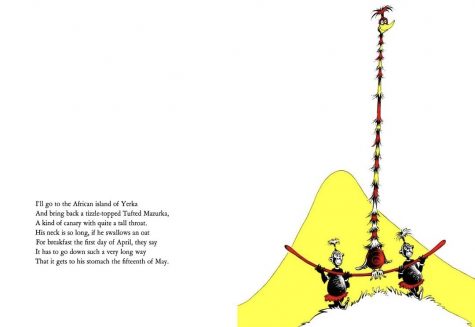
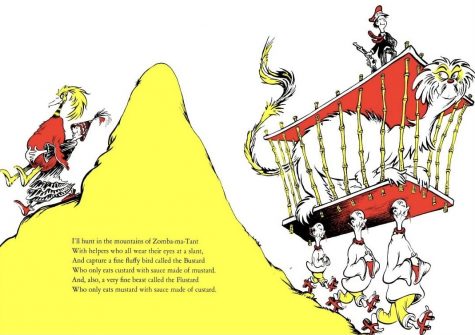
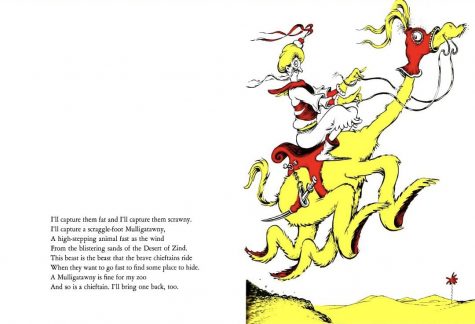
McElligot’s Pool (1947) contains imagery of Inuit fish referred to as “Eskimo fish” donning traditional furs as they swim through icy waters. An Inuit man watches from the distance, standing on a piece of ice on which an igloo also rests.
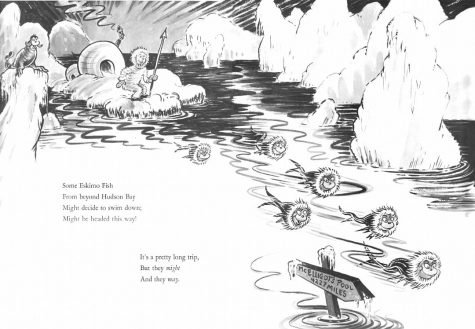
On Beyond Zebra! (1955) contains an illustration of a stereotypically depicted South Asian character.

Similar to McElligot’s Pool, Scrambled Eggs Super! (1953) also shows a group of stereotypically portrayed Inuit figures, though they are not referred to as such.
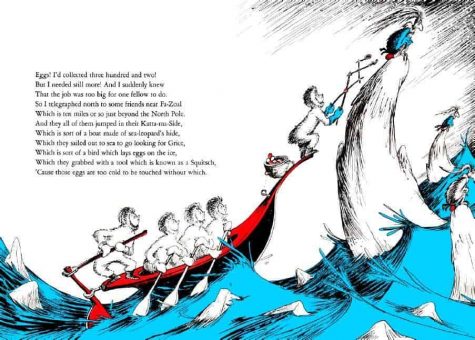
Finally is The Cat’s Quizzer (1976) which asks the question, “How old do you have to be to be a Japanese?” A Japanese man is shown in a small illustration waving to the reader and standing on a scaled down version of Mount Fuji while a torri (a traditional Japanese gate) can be seen nearby. The book itself is a collection of various questions, statements, and riddles that range from bizarre, to silly, to completely nonsensical. For instance, “It is not safe to ride backwards on an ostrich,” or “Which grows faster? An uncle’s eyebrows…? Or an uncle’s mustache?”
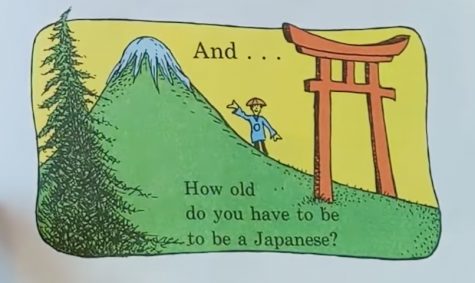
I can understand why many people find these images upsetting. They boil down people and cultures to specific stereotypes that rarely apply. However, I still believe that those who chose to ban these books are still missing a key point.
Aldous Huxley, in the forward to a republished version of Brave New World, made a statement that I feel is very appropriate in relation to the controversy over Dr. Seuss’s works:
“Art also has its morality, and many of the rules of this morality are the same as, or at least analogous to, the rules of ordinary ethics. Remorse, for example, is as undesirable in relation to our bad art as it is in relation to our bad behavior. The badness should be hunted out, acknowledged, and if possible, avoided in the future. To pore over the literary shortcomings of twenty years ago, to attempt to patch a faulty work into the perfection it missed at its first execution…all this is surely vain and futile.”
To rewrite the past and remove its traces from the present and the future is to deny history, and, therefore, deny the nature of progress. A deep wound can be covered with a bandage, but the bandage itself is not what heals. Time, attention, and care heal. Whether we like it or not, we must admit to ourselves that, during the various periods of time in which these books were produced, culture was far different and far less sensitive to the feelings of minorities. Racism and stereotyping penetrated all parts of life, and many people engaged in it, some completely oblivious to the harmful effects it produced. Caricatures of different people and cultures were utilized frequently, but not always out of ill-intent. There is a big difference between showing a stereotypical, watered-down version of a person’s culture and intentionally portraying a culture in a way that makes its people appear heinous, disgusting, or cruel. A comparison between the Inuit’s portrayed in Dr. Seuss’s books and those shown in the often ignored film North show this difference perfectly. On one hand, you have illustrations that show a surface-level concept of Inuit culture. On the other hand, you have a film that makes a complete mockery of the Inuit people through crass jokes about lifestyle and traditions all while having an Inuit character portrayed by a white individual wearing face paint and a wig.
The difference is clear. Neither situation is desirable and both can be harmful.

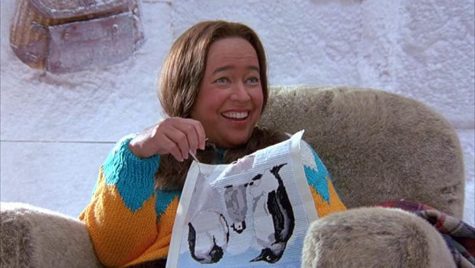
However, it is always important to keep intent in mind when looking at something that is sensitive and outdated. This leads to the primary reason why I believe that none of these Dr. Seuss books should be banned. There is so much that we can learn from the past. Most importantly, we can learn what not to repeat so that we can have a better future. By censoring or eliminating media that represents that past as it was, even if it appears unpleasant today, shields people from reality and leads them to an idealized understanding of the world that simply is not realistic.
A great place to start when it comes to acknowledging the past is classic cinema. Movies like Breakfast at Tiffany’s, Sixteen Candles, The King and I, and even a portion of Annie all contain instances of racial stereotyping and insensitivity. Unlike the Dr. Seuss books that are being banned, however, they remain easily accessible to all audiences. Educational tools that explain why these racist undertones were once permitted in these films but would not be accepted today are widely available and help aid us in the process of learning from the past.
An appropriate compromise to be made for these Dr. Seuss books would be the inclusion of a disclaimer explaining to parents that, if they do not want their children to see this imagery they can choose not to buy the books. If parents do want to show them to their children, there should be, perhaps, addendums or a companion book that explains stereotyping and racism in a way that children can understand. In very simple terms, it would explain that some things that were okay at one time are not anymore.
Over time, people have become more aware of the feelings of others which has made the world a kinder place to be in. Not everyone is the same. We all have differences that make us unique. What is important is to not focus on these differences as a bad thing, but to embrace them and make one another feel good about being ourselves.
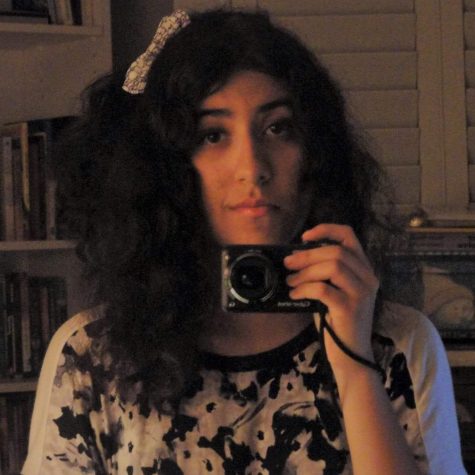
Madeline Phelps is a senior currently attending Arroyo Grande High School, from a distance, of course. When she isn’t doing schoolwork or sitting around...






